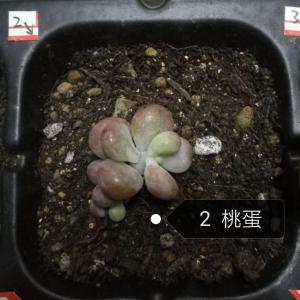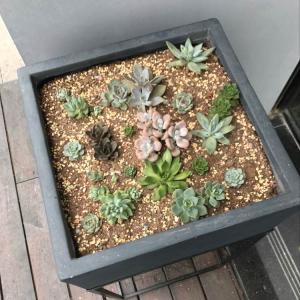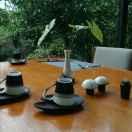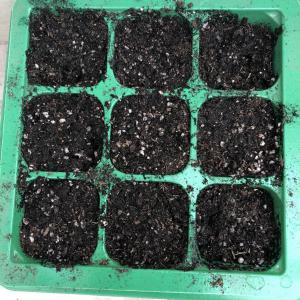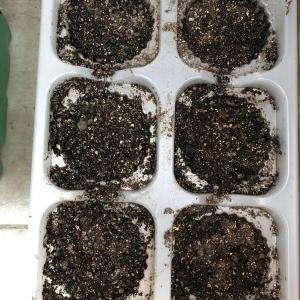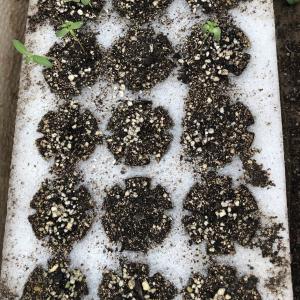文章
Miss Chen
2018年05月11日

Description: This perennial wildflower is ¾–2' tall with erect to ascending stems. These stems are sometimes branched at the base, otherwise they are unbranched (except when axillary inflorescences are present). The stems are light green, 4-angled, and glabrous to sparsely hairy. At intervals along these stems, there are whorls of 4 leaves. The leaves are up to 2½" long and 1" across, lanceolate-ovate to ovate, medium green, sessile, and sparsely pubescent on both the lower and upper sides. Their margins are smooth and ciliate. Each leaf has 3 prominent parallel veins. Usually, the leaves toward the middle of each stem are largest. Each major stem terminates in a dichotomously forked inflorescence that produces only a few flowers; sometimes smaller inflorescences develop from the axils of the upper leaves. Like the stems, the branches of each inflorescence are 4-angled, light green, and glabrous to sparsely hairy. At each fork of the inflorescence, there are 0-4 small bracts that are linear or linear-lanceolate in shape.
The flowers occur individually along these branches and they are usually sessile (or nearly so). Each flower is about 1/8" (3 mm.) across, consisting of a corolla with 4 lobes, a double-ovoid ovary, 4 stamens, and a pair of styles. The corolla is usually greenish white or greenish yellow; less often, it is purple. The immature ovary is green, bristly, and 2-celled. The blooming period usually occurs during the early summer and lasts about a month. At maturity, each ovary becomes a dry fruit that is black or dark brown, globoid in shape, and covered with hooked bristles. One cell of this fruit produces a single nutlet, while the other cell becomes a small fleshy elaiosome (food appendage). The root system is fibrous and rhizomatous. This wildflower spreads by reseeding itself or vegetatively through its rhizomes.
Cultivation: The preference is dappled sunlight to medium shade, mesic to dry conditions, and a loamy or rocky soil with some decaying organic matter (e.g., fallen leaves). The foliage usually remains in good condition throughout the summer.
Range & Habitat: The native Wild Licorice is occasional to locally common throughout Illinois (see Distribution Map). Habitats include mesic to dry deciduous woodlands, bluffs, woodland borders, areas along woodland paths, thickets, and limestone glades.

Faunal Associations: The flowers are visited sparingly by small bees and miscellaneous flies; these insects usually seek nectar. The caterpillars of several moths feed on Galium spp. (Bedstraws), including Lobocleta ossularia (Drab Brown Wave), Pleuroprucha insulsaria (Common Tan Wave), Scopula limboundata (Large Lace Border), Epirrhoe alternata (White-banded Toothed Carpet), and Hyles gallii (Galium Sphinx). Bedstraws are summer hosts of Myzus cerasi (Black Cherry Aphid); another aphid, Aphis gossypii (Cotton Aphid), has been found on the leaves of Wild Licorice. Among vertebrate animals, the Eastern Box Turtle occasionally eats the foliage of bedstraws in woodlands; White-tailed Deer also eat the foliage of these plants to a limited extent. The hooked bristles of the fruits can cling to the fur of mammals and the clothing of humans; this distributes the seeds into new areas. Because each fruit contains an elaiosome that is attractive to ants, these insects also help to distribute the seeds.
Photographic Location: A deciduous woodland at Pine Hills Nature Preserve in west-central Indiana.
Comments: While the flowers are not very showy, the foliage is reasonably attractive. Wild Licorice has larger leaves than most Galium spp. (Bedstraws). In addition to this characteristic, it can be distinguished from other bedstraws by its whorls of 4 leaves, pubescent leaves, bristly fruit, and/or flowers that are sessile along the branches of each inflorescence. A very similar species, Galium lanceolatum (Lance-Leaved Wild Licorice), has hairless leaves that are more narrow toward their tips, and its flowers are usually purple. Both of these species prefer shaded habitats that are rather dry.
The flowers occur individually along these branches and they are usually sessile (or nearly so). Each flower is about 1/8" (3 mm.) across, consisting of a corolla with 4 lobes, a double-ovoid ovary, 4 stamens, and a pair of styles. The corolla is usually greenish white or greenish yellow; less often, it is purple. The immature ovary is green, bristly, and 2-celled. The blooming period usually occurs during the early summer and lasts about a month. At maturity, each ovary becomes a dry fruit that is black or dark brown, globoid in shape, and covered with hooked bristles. One cell of this fruit produces a single nutlet, while the other cell becomes a small fleshy elaiosome (food appendage). The root system is fibrous and rhizomatous. This wildflower spreads by reseeding itself or vegetatively through its rhizomes.
Cultivation: The preference is dappled sunlight to medium shade, mesic to dry conditions, and a loamy or rocky soil with some decaying organic matter (e.g., fallen leaves). The foliage usually remains in good condition throughout the summer.
Range & Habitat: The native Wild Licorice is occasional to locally common throughout Illinois (see Distribution Map). Habitats include mesic to dry deciduous woodlands, bluffs, woodland borders, areas along woodland paths, thickets, and limestone glades.

Faunal Associations: The flowers are visited sparingly by small bees and miscellaneous flies; these insects usually seek nectar. The caterpillars of several moths feed on Galium spp. (Bedstraws), including Lobocleta ossularia (Drab Brown Wave), Pleuroprucha insulsaria (Common Tan Wave), Scopula limboundata (Large Lace Border), Epirrhoe alternata (White-banded Toothed Carpet), and Hyles gallii (Galium Sphinx). Bedstraws are summer hosts of Myzus cerasi (Black Cherry Aphid); another aphid, Aphis gossypii (Cotton Aphid), has been found on the leaves of Wild Licorice. Among vertebrate animals, the Eastern Box Turtle occasionally eats the foliage of bedstraws in woodlands; White-tailed Deer also eat the foliage of these plants to a limited extent. The hooked bristles of the fruits can cling to the fur of mammals and the clothing of humans; this distributes the seeds into new areas. Because each fruit contains an elaiosome that is attractive to ants, these insects also help to distribute the seeds.
Photographic Location: A deciduous woodland at Pine Hills Nature Preserve in west-central Indiana.
Comments: While the flowers are not very showy, the foliage is reasonably attractive. Wild Licorice has larger leaves than most Galium spp. (Bedstraws). In addition to this characteristic, it can be distinguished from other bedstraws by its whorls of 4 leaves, pubescent leaves, bristly fruit, and/or flowers that are sessile along the branches of each inflorescence. A very similar species, Galium lanceolatum (Lance-Leaved Wild Licorice), has hairless leaves that are more narrow toward their tips, and its flowers are usually purple. Both of these species prefer shaded habitats that are rather dry.
0
0
文章
Miss Chen
2018年05月11日

Description: This annual plant is up to 1' long and sparingly branched. Its slender stems are glabrous and sprawling to erect. The alternate leaves are up to 3" long and 2" across; they are pinnately compound with 3-7 narrow leaflets. Each leaflet is linear-oblong, smooth along the margins, and hairless.Close-up of Flower Occasionally, a leaflet may be cleft into 2-3 narrow lobes. Both the stems and leaves are light green and rather mossy in appearance. Individual flowers develop from the axils of the upper leaves. Each flower is about ¼" across, consisting of 3 green sepals, 3 white petals, 6 stamens (usually), and a single style. The sepals are lanceolate-ovate and much larger than the petals. The petals are narrowly oblong and inconspicuous. The slender pedicel of each flower is about 1" long. The blooming period occurs from mid- to late spring and lasts about a month. During the heat of summer, the foliage turns yellow and quickly withers away. Each flower develops 1-3 carpels that are globoid and bumpy across the upper surface. The carpels are initially pale green or pale yellow, but they later turn brown and release the seeds. The root system consists of a slender branching taproot. This plant spreads by reseeding itself, and it often form colonies at favorable sites.
Cultivation: The preference is diffuse sunlight to light shade during the spring when vegetative growth and development occurs, otherwise it can be quite shady. The soil should be consistently moist and loamy or silty. This plant doesn't like to dry out.
Range & Habitat: The native False Mermaid occurs occasionally in northern and east central Illinois, otherwise it is rare or absent (see Distribution Map). Habitats include moist to mesic deciduous woodlands and low-lying areas along springs and small rivers in wooded areas. False Mermaid is usually found in high quality woodlands where the original flora is still intact. This is one of the spring wildflowers in woodlands that is threatened by the invasion of Alliaria petiolata (Garlic Mustard).
Faunal Associations: The small inconspicuous flowers can attract flower flies and small bees. The foliage is not known to be toxic and may be edible to mammalian herbivores, although little is known about floral-faunal relationships for this species.
Photographic Location: A moist area of Busey Woods in Urbana, Illinois.

Comments: This inconspicuous little plant is easy to overlook, except where it occurs in sizable colonies along the woodland floor. The delicate foliage is attractive and resembles moss or a Galium sp. (Bedstraw). It isn't immediately obvious when False Mermaid is blooming as the flowers are inconspicuous – careful inspection at the right time during the spring will reveal the green sepals, tiny white petals, and the stamens. It is fairly easy to identify this plant because each flower has only 3 sepals and 3 petals, while the alternate leaves are pinnately compound. Other woodland plants with a similar appearance include Galium spp. (Bedstraws) and Ellisia nyctelea (Aunt Lucy). Bedstraws have flowers with 4 petals and their simple leaves occur in whorls. Aunt Lucy has pinnately compound leaves, but its flowers have 5 white petals and its foliage is more or less hairy.
Cultivation: The preference is diffuse sunlight to light shade during the spring when vegetative growth and development occurs, otherwise it can be quite shady. The soil should be consistently moist and loamy or silty. This plant doesn't like to dry out.
Range & Habitat: The native False Mermaid occurs occasionally in northern and east central Illinois, otherwise it is rare or absent (see Distribution Map). Habitats include moist to mesic deciduous woodlands and low-lying areas along springs and small rivers in wooded areas. False Mermaid is usually found in high quality woodlands where the original flora is still intact. This is one of the spring wildflowers in woodlands that is threatened by the invasion of Alliaria petiolata (Garlic Mustard).
Faunal Associations: The small inconspicuous flowers can attract flower flies and small bees. The foliage is not known to be toxic and may be edible to mammalian herbivores, although little is known about floral-faunal relationships for this species.
Photographic Location: A moist area of Busey Woods in Urbana, Illinois.

Comments: This inconspicuous little plant is easy to overlook, except where it occurs in sizable colonies along the woodland floor. The delicate foliage is attractive and resembles moss or a Galium sp. (Bedstraw). It isn't immediately obvious when False Mermaid is blooming as the flowers are inconspicuous – careful inspection at the right time during the spring will reveal the green sepals, tiny white petals, and the stamens. It is fairly easy to identify this plant because each flower has only 3 sepals and 3 petals, while the alternate leaves are pinnately compound. Other woodland plants with a similar appearance include Galium spp. (Bedstraws) and Ellisia nyctelea (Aunt Lucy). Bedstraws have flowers with 4 petals and their simple leaves occur in whorls. Aunt Lucy has pinnately compound leaves, but its flowers have 5 white petals and its foliage is more or less hairy.
0
0
文章
Miss Chen
2018年05月11日

Description: This herbaceous perennial plant consists of 1 or 2 basal leaves and a single-flowered inflorescence up to 6" tall. The basal leaves are 2½-6" long and ½-2" across; they are ascending to erect, elliptic-lanceolate in shape, and smooth (entire) along their margins. The upper leaf surface is mottled pale green and brown or greenish brown, while the lower surface is solid medium green; both surfaces are glabrous and the lower surface is often glaucous. The petioles of these leaves are relatively long, but they are located mostly or entirely underneath the ground surface. Immature shoots are single-leaved and they produce no flowers, while mature shoots have two leaves and they are single-flowered. Immature shoots are more common than mature shoots.
The inflorescence has a long flowering stalk that is terete, glabrous, and light green to pale reddish brown. This stalk is mostly erect or ascending, but it nods downward at its tip where the flower occurs. The nodding flower is ¾-1¼" long, consisting of 6 yellow tepals, 6 stamens, and an ovary with 3 erect stigmata. Initially, the tepals are barely separated from each other, but as the flower matures they become strongly recurved, exposing the reproductive organs. These tepals are narrowly elliptic-lanceolate in shape, and they are often tinted red or reddish brown along their outer sides. The stamens are about ½" long and their anthers are yellow or yellow-brown. The blooming period occurs during mid-spring and lasts about 2 weeks. Afterwards, the flowers are replaced by obovoid seed capsules that are about ½" in length or a little longer. These capsules are glabrous and their apices are truncate to rounded. At maturity, these capsules divide into 3 parts to release their seeds.

The root system consists of a corm with fibrous roots underneath, and 0-3 stolons. The stolons extend below the leaf litter, creating clonal offshoots from the mother plant. As a result, colonies of plants are often formed, consisting largely of immature shoots.
Cultivation: The preference is dappled sunlight to medium shade, more or less mesic conditions, and loamy soil with leaf litter and decaying organic matter. Most growth and development occurs during the spring before the trees fully develop their vernal leaves. This wildflower adapts readily to the shade of various deciduous trees. It takes several years of development (typically about 8 years) before individual plants will flower in a typical woodland setting.

Range & Habitat: The native Yellow Trout Lily is occasional in southern Illinois, while in the rest of the state it is uncommon or absent (see Distribution Map). Outside of southern Illinois, it is largely restricted to the eastern half of the state. Illinois lies toward the western range limit of this plant; it is more common further to the east. Habitats include rich woodlands, wooded bluffs, rocky woodlands, and banks of streams. Yellow Trout Lily is found in deciduous woodlands, where Sugar Maple (Acer saccharum), American Beech (Fagus grandifolia), and other deciduous trees are present.

Faunal Associations: The nectar and pollen of the flowers attract largely bees, including bumblebees, Mason bees, and Andrenid bees. One bee species, Andrena erythronii, is a weak oligolege (specialist pollinator) of Erythronium spp. (Trout Lilies). Like several other woodland wildflowers, the seeds of Yellow Trout Lily are distributed in part by ants, which are attracted to their food appendages. Because the leaves of this plant are relatively small and inconspicuous, they are browsed by White-tailed Deer to only a limited extent. The mottled pattern of the leaves helps to disguise them from such mammalian herbivores as they lack color vision.
Photographic Location: A deciduous woodland at Jim Smith's farm in Vermilion County, Illinois.

Comments: This is the only yellow-flowered Trout Lily (Erythronium) in Illinois, making it easy to identify. The other two species of Trout Lily within the state, Erythronium albidum (White Trout Lily) and Erythronium mesochoreum (Prairie Trout Lily), have either white flowers or bluish white flowers. Both the flowers and foliage of Yellow Trout Lily are quite attractive, although the blooming period is rather short and most plants fail to flower during any given year. In Illinois, Yellow Trout Lily is much less common than White Trout Lily. However, in states further to the east, the reverse is true: Yellow Trout Lily is more common than White Trout Lily.
The inflorescence has a long flowering stalk that is terete, glabrous, and light green to pale reddish brown. This stalk is mostly erect or ascending, but it nods downward at its tip where the flower occurs. The nodding flower is ¾-1¼" long, consisting of 6 yellow tepals, 6 stamens, and an ovary with 3 erect stigmata. Initially, the tepals are barely separated from each other, but as the flower matures they become strongly recurved, exposing the reproductive organs. These tepals are narrowly elliptic-lanceolate in shape, and they are often tinted red or reddish brown along their outer sides. The stamens are about ½" long and their anthers are yellow or yellow-brown. The blooming period occurs during mid-spring and lasts about 2 weeks. Afterwards, the flowers are replaced by obovoid seed capsules that are about ½" in length or a little longer. These capsules are glabrous and their apices are truncate to rounded. At maturity, these capsules divide into 3 parts to release their seeds.

The root system consists of a corm with fibrous roots underneath, and 0-3 stolons. The stolons extend below the leaf litter, creating clonal offshoots from the mother plant. As a result, colonies of plants are often formed, consisting largely of immature shoots.
Cultivation: The preference is dappled sunlight to medium shade, more or less mesic conditions, and loamy soil with leaf litter and decaying organic matter. Most growth and development occurs during the spring before the trees fully develop their vernal leaves. This wildflower adapts readily to the shade of various deciduous trees. It takes several years of development (typically about 8 years) before individual plants will flower in a typical woodland setting.

Range & Habitat: The native Yellow Trout Lily is occasional in southern Illinois, while in the rest of the state it is uncommon or absent (see Distribution Map). Outside of southern Illinois, it is largely restricted to the eastern half of the state. Illinois lies toward the western range limit of this plant; it is more common further to the east. Habitats include rich woodlands, wooded bluffs, rocky woodlands, and banks of streams. Yellow Trout Lily is found in deciduous woodlands, where Sugar Maple (Acer saccharum), American Beech (Fagus grandifolia), and other deciduous trees are present.

Faunal Associations: The nectar and pollen of the flowers attract largely bees, including bumblebees, Mason bees, and Andrenid bees. One bee species, Andrena erythronii, is a weak oligolege (specialist pollinator) of Erythronium spp. (Trout Lilies). Like several other woodland wildflowers, the seeds of Yellow Trout Lily are distributed in part by ants, which are attracted to their food appendages. Because the leaves of this plant are relatively small and inconspicuous, they are browsed by White-tailed Deer to only a limited extent. The mottled pattern of the leaves helps to disguise them from such mammalian herbivores as they lack color vision.
Photographic Location: A deciduous woodland at Jim Smith's farm in Vermilion County, Illinois.

Comments: This is the only yellow-flowered Trout Lily (Erythronium) in Illinois, making it easy to identify. The other two species of Trout Lily within the state, Erythronium albidum (White Trout Lily) and Erythronium mesochoreum (Prairie Trout Lily), have either white flowers or bluish white flowers. Both the flowers and foliage of Yellow Trout Lily are quite attractive, although the blooming period is rather short and most plants fail to flower during any given year. In Illinois, Yellow Trout Lily is much less common than White Trout Lily. However, in states further to the east, the reverse is true: Yellow Trout Lily is more common than White Trout Lily.
0
0
文章
Miss Chen
2018年05月10日

Description: This herbaceous perennial plant is about 4-6" tall, consisting of 1-2 basal leaves and a flowering stalk with a single flower. Immature plants produce a single leaf and fail to flower, while mature plants that bloom produce a pair of leaves. The basal leaves are up to 6" long and 2" across. They are elliptic, lanceolate, or narrowly ovate, and smooth (entire) along their margins. The upper leaf surface is mottled pale green and brownish or grayish green, while the lower leaf surface is pale to medium green. Both leaf surfaces are glabrous; the upper leaf surface is often waxy. The leaves often curve upward slightly from the midvein to the margins. A naked flowering stalk develops between the basal leaves of mature plants. This stalk is light green to reddish brown and glabrous; it nods downward at its apex, where the flower occurs.
Each nodding flower is about 1½" long and across; it consists of 6 white tepals, 6 stamens with long yellow anthers, and a slender style with a stigma that has 3 lobes that spread outward. The tepals are linear-lanceolate and strongly recurved, while the stamens and style are exerted. The blooming period occurs during mid-spring and lasts about 2 weeks. Each fertilized flower is replaced by a 3-chambered seed capsule that is ovoid and about ¾" long. Each chamber of the seed capsule contains 2 rows of flattened seeds. The root system consists of a corm that is several inches below the surface of the ground; this corm produces fibrous roots at its base and occasionally sends out underground stolons that can form new plants a few inches away from the mother plant. White Trout Lily can produce large colonies of plants if it is left undisturbed for several decades.

Cultivation: The preference is dappled sunlight during the spring, moist to mesic conditions, and a rich loamy soil with decaying leaf mould. Situations involving more shade are tolerated later in the year. The foliage withers away during the summer. It takes several years for a new plant to fully develop and bloom. Corms can be transplanted successfully during the fall, while the establishment of new plants from seeds is difficult and slow.
Range & Habitat: The native White Trout Lily is a common plant that occurs in every county of Illinois, except for Jo Davies county in the extreme NW corner of the state (see Distribution Map). Habitats include moist to mesic deciduous woodlands and gentle slopes in wooded areas. An abundance of this plant indicates that a woodlands has never been subjected to the plow or bulldozed over. White Trout Lily is one of the spring wildflowers that is threatened by the spread of Alliaria petiolata (Garlic Mustard) in wooded areas.

Faunal Associations: The flowers are primarily pollinated by both long-tongued and short-tongued bees, including honeybees, mason bees (Osmia spp.), cuckoo bees (Nomada spp.), digger bees (Synhalonia belfragii), Halictid bees (Halictus spp., Lasioglossum spp.), plasterer bees (Colletes inaequalis), and Andrenid bees (Andrena spp.). The bees suck nectar from the flowers; honeybees and short-tongued bees also collect pollen. An oligolectic bee of Erythronium spp. (Trout Lilies) is Andrena erythronii. Less typical insects visiting the flowers for nectar include the Giant Bee Fly (Bombylius major), butterflies, and skippers. Trout Lilies (Erythronium spp.) are occasionally eaten by White-tailed Deer, but the damage is usually minor because of the low stature and ephemeral nature of the foliage.
Photographic Location: A deciduous woodlands at Busey Woods in Urbana, Illinois.

Comments: White Trout Lily usually blooms a little earlier than other spring wildflowers in woodlands; this blooming period is short, and immature plants that don't bloom always outnumber mature plants. Both the flowers and foliage are attractive (especially if the latter is mottled). The other Trout Lilies in Illinois are less common; they include Erythronium americanum (Yellow Trout Lily) and Erythronium mesochoreum (Prairie Trout Lily). Yellow Trout Lily has yellow flowers and the lobes of its stigmas are united, rather than spreading. Prairie Trout Lily resembles a White Trout Lily with unmottled foliage. However, it produces a larger seed capsule (about 1" long) that nods downward from its stalk, sometimes touching the ground. White Trout Lily has a smaller seed capsule (about ¾" long) that remains more or less erect on its stalk. The flowers of Prairie Trout Lily are light blue-violet more often than those of White Trout Lily, and its basal leaves tend to be less broad and more strongly folded upward along their midveins.
Each nodding flower is about 1½" long and across; it consists of 6 white tepals, 6 stamens with long yellow anthers, and a slender style with a stigma that has 3 lobes that spread outward. The tepals are linear-lanceolate and strongly recurved, while the stamens and style are exerted. The blooming period occurs during mid-spring and lasts about 2 weeks. Each fertilized flower is replaced by a 3-chambered seed capsule that is ovoid and about ¾" long. Each chamber of the seed capsule contains 2 rows of flattened seeds. The root system consists of a corm that is several inches below the surface of the ground; this corm produces fibrous roots at its base and occasionally sends out underground stolons that can form new plants a few inches away from the mother plant. White Trout Lily can produce large colonies of plants if it is left undisturbed for several decades.

Cultivation: The preference is dappled sunlight during the spring, moist to mesic conditions, and a rich loamy soil with decaying leaf mould. Situations involving more shade are tolerated later in the year. The foliage withers away during the summer. It takes several years for a new plant to fully develop and bloom. Corms can be transplanted successfully during the fall, while the establishment of new plants from seeds is difficult and slow.
Range & Habitat: The native White Trout Lily is a common plant that occurs in every county of Illinois, except for Jo Davies county in the extreme NW corner of the state (see Distribution Map). Habitats include moist to mesic deciduous woodlands and gentle slopes in wooded areas. An abundance of this plant indicates that a woodlands has never been subjected to the plow or bulldozed over. White Trout Lily is one of the spring wildflowers that is threatened by the spread of Alliaria petiolata (Garlic Mustard) in wooded areas.

Faunal Associations: The flowers are primarily pollinated by both long-tongued and short-tongued bees, including honeybees, mason bees (Osmia spp.), cuckoo bees (Nomada spp.), digger bees (Synhalonia belfragii), Halictid bees (Halictus spp., Lasioglossum spp.), plasterer bees (Colletes inaequalis), and Andrenid bees (Andrena spp.). The bees suck nectar from the flowers; honeybees and short-tongued bees also collect pollen. An oligolectic bee of Erythronium spp. (Trout Lilies) is Andrena erythronii. Less typical insects visiting the flowers for nectar include the Giant Bee Fly (Bombylius major), butterflies, and skippers. Trout Lilies (Erythronium spp.) are occasionally eaten by White-tailed Deer, but the damage is usually minor because of the low stature and ephemeral nature of the foliage.
Photographic Location: A deciduous woodlands at Busey Woods in Urbana, Illinois.

Comments: White Trout Lily usually blooms a little earlier than other spring wildflowers in woodlands; this blooming period is short, and immature plants that don't bloom always outnumber mature plants. Both the flowers and foliage are attractive (especially if the latter is mottled). The other Trout Lilies in Illinois are less common; they include Erythronium americanum (Yellow Trout Lily) and Erythronium mesochoreum (Prairie Trout Lily). Yellow Trout Lily has yellow flowers and the lobes of its stigmas are united, rather than spreading. Prairie Trout Lily resembles a White Trout Lily with unmottled foliage. However, it produces a larger seed capsule (about 1" long) that nods downward from its stalk, sometimes touching the ground. White Trout Lily has a smaller seed capsule (about ¾" long) that remains more or less erect on its stalk. The flowers of Prairie Trout Lily are light blue-violet more often than those of White Trout Lily, and its basal leaves tend to be less broad and more strongly folded upward along their midveins.
0
0
成长记
2B_BotanicalFie
2018年05月10日

String of Pearls 2 & 3 combined.
Lets see how they will continue living together from here!

Lets see how they will continue living together from here!

2
0
sofiag
2018年05月09日

My boyfriend gifted me 2 succulents for my birthday(5/7/18), among other things. He named the Moon Cactus ‘Cherry Cactus’ ❤️
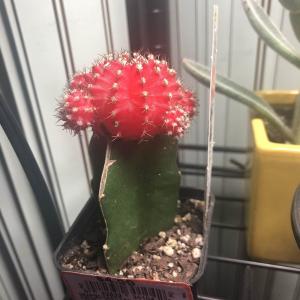
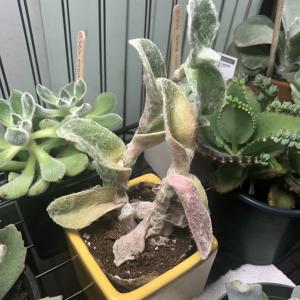


0
0
文章
Miss Chen
2018年05月09日

Description: This herbaceous perennial plant develops 1-2 compound basal leaves during the spring. The blades of these leaves are 3-7" long and 3-7" across; they are ascending to more or less parallel with the ground. Each leaf blade is divided into 3 leaflets (1 terminal & 2 lateral leaflets). In less developed leaves, the leaflets are pinnate-pinnatifid, ultimately dividing into narrow parallel lobes. However, in more developed leaves, each leaflet divides into 3 subleaflets, and these subleaflets are pinnate-pinnatifid, ultimately dividing into narrow lobes. The ultimate lobes of these leaves are ¼–½" long and about 3 mm. (1/8") across; they are linear, linear-elliptic, or linear-oblanceolate in shape with entire (toothless) margins and bluntly acute tips. The upper leaf surface is grayish green to medium green, glabrous, and sometimes slightly glaucous, while the lower leaf surface is white to greenish white, glabrous, and very glaucous. For each compound leaf, the petiolule (basal stalklet) of the terminal leaflet is longer than those of the 2 lateral leaflets. The petioles of the compound leaves are 3-6" long and ascending; they are pale red to pale reddish green, terete, glabrous, and often glaucous.
An inflorescence consisting of a raceme of flowers sometimes develops shortly after the formation of basal leaves. This inflorescence is 6-12" tall and it is either erect or ascending. The peduncle (basal stalk) of the inflorescence is pale red or pale yellowish green, terete, glabrous, and glaucous. Each raceme has 3-10 pendant flowers. The corolla of the pendant flower is ½–¾" long, mostly white, narrowly obcordoid in shape, and somewhat flattened. Two fused outer petals form the rounded nectar spurs (above), the lateral sides, and the pair of of upturned lips (below) of the corolla. Two fused inner petals form a pair of transverse crests and a pair of small inner claws near the entrance of the corolla. The small lips are shaped like keeled hoods with translucent parallel veins. The flat crests are half-cordate in shape, slightly wrinkled, slightly undulate, and white; sometimes they are pinkish along their bases. Inserted within the corolla is a pistil with a single style and several stamens. There are also a pair of tiny sepals; they are about 2-3 mm. long, linear-lanceolate in shape, and light pink with whitish margins. The nodding pedicels of the flowers are pale green or pale reddish green, terete, glabrous, and sometimes glaucous; they are up to ¼" long. At the bases of these pedicels, there are solitary floral bracts about 3-5 mm. long; they are ovate to obovate in shape and light pink with whitish margins.

The blooming period occurs during mid-spring for about 2-3 weeks. The flowers have a sweet fragrance. Afterwards, fertile flowers are replaced by drooping seed capsules that become about 12 mm. (½") long at maturity; these capsules are ovoid in shape and somewhat flattened. Each capsule divides into 2 parts to release its seeds; there are several seeds per capsule. The seeds are 1-2 mm. long, short-reniform in shape, and obscurely reticulate; each seed has an attached elaiosome (food appendage). The foliage dies down by mid-summer. The root system consists of a cluster of yellow globoid corms and fibrous roots.
Cultivation: The preference is dappled sunlight to medium shade, mesic conditions, and a loose loamy soil with decaying organic matter. Growth and development occur during the spring. Germination of the seeds can be slow and difficult, although it may be possible to start new plants by separating some of the corms. Insects and disease organisms are rarely troublesome.

Range & Habitat: The native Squirrel Corn occurs primarily in NE, east-central, and the southern tip of Illinois, where it is uncommon (see Distribution Map). Illinois lies toward the western range limit of this species; it is more common further to the east. Habitats include mesic deciduous woodlands, wooded bluffs, wooded slopes, ravines, and shaded stream banks. Squirrel Corn is found in high quality woodlands in Illinois, where the native ground flora is intact. It is one of the spring wildflowers that is threatened by the invasion of Garlic Mustard (Alliaria petiolata) and some Eurasian shrubs, particularly Amur Honeysuckle (Lonicera maackii).
Faunal Associations: The flowers are cross-pollinated primarily by queen bumblebees. Both nectar and pollen are available as floral rewards. The seeds are distributed to some extent by ants because of their elaisomes (food appendages). Because the foliage is toxic, it is usually avoided by mammalian herbivores. The overall value of this plant to faunal wildlife is low.

Photographic Location: A deciduous woodland at Jim Smith's farm in Vermilion County, Illinois.
Comments: This is another wonderful spring wildflower that can be found in eastern deciduous woodlands. Both the foliage and flowers of Squirrel Corn (Dicentra canadensis) are similar in appearance to those of Dutchman's Breeches (Dicentra cucullaria). Both of these species are found in similar habitats and their blooming periods overlap (Squirrel Corn begins to bloom about 1 week later). However, Dutchman's Breeches is by far the more common wildflower in Illinois. The flowers of Squirrel Corn have short rounded nectar spurs, while those of Dutch's Breeches are longer and more narrow. The basal leaves of these two species are very difficult to distinguish, although those of Squirrel Corn appear to have slightly longer ultimate lobes on average. The corms of these two species are also different in appearance: the corms of Squirrel Corn are yellow and globoid in shape, while the corms of Dutchman's Breeches are pink and more ovoid in shape.
An inflorescence consisting of a raceme of flowers sometimes develops shortly after the formation of basal leaves. This inflorescence is 6-12" tall and it is either erect or ascending. The peduncle (basal stalk) of the inflorescence is pale red or pale yellowish green, terete, glabrous, and glaucous. Each raceme has 3-10 pendant flowers. The corolla of the pendant flower is ½–¾" long, mostly white, narrowly obcordoid in shape, and somewhat flattened. Two fused outer petals form the rounded nectar spurs (above), the lateral sides, and the pair of of upturned lips (below) of the corolla. Two fused inner petals form a pair of transverse crests and a pair of small inner claws near the entrance of the corolla. The small lips are shaped like keeled hoods with translucent parallel veins. The flat crests are half-cordate in shape, slightly wrinkled, slightly undulate, and white; sometimes they are pinkish along their bases. Inserted within the corolla is a pistil with a single style and several stamens. There are also a pair of tiny sepals; they are about 2-3 mm. long, linear-lanceolate in shape, and light pink with whitish margins. The nodding pedicels of the flowers are pale green or pale reddish green, terete, glabrous, and sometimes glaucous; they are up to ¼" long. At the bases of these pedicels, there are solitary floral bracts about 3-5 mm. long; they are ovate to obovate in shape and light pink with whitish margins.

The blooming period occurs during mid-spring for about 2-3 weeks. The flowers have a sweet fragrance. Afterwards, fertile flowers are replaced by drooping seed capsules that become about 12 mm. (½") long at maturity; these capsules are ovoid in shape and somewhat flattened. Each capsule divides into 2 parts to release its seeds; there are several seeds per capsule. The seeds are 1-2 mm. long, short-reniform in shape, and obscurely reticulate; each seed has an attached elaiosome (food appendage). The foliage dies down by mid-summer. The root system consists of a cluster of yellow globoid corms and fibrous roots.
Cultivation: The preference is dappled sunlight to medium shade, mesic conditions, and a loose loamy soil with decaying organic matter. Growth and development occur during the spring. Germination of the seeds can be slow and difficult, although it may be possible to start new plants by separating some of the corms. Insects and disease organisms are rarely troublesome.

Range & Habitat: The native Squirrel Corn occurs primarily in NE, east-central, and the southern tip of Illinois, where it is uncommon (see Distribution Map). Illinois lies toward the western range limit of this species; it is more common further to the east. Habitats include mesic deciduous woodlands, wooded bluffs, wooded slopes, ravines, and shaded stream banks. Squirrel Corn is found in high quality woodlands in Illinois, where the native ground flora is intact. It is one of the spring wildflowers that is threatened by the invasion of Garlic Mustard (Alliaria petiolata) and some Eurasian shrubs, particularly Amur Honeysuckle (Lonicera maackii).
Faunal Associations: The flowers are cross-pollinated primarily by queen bumblebees. Both nectar and pollen are available as floral rewards. The seeds are distributed to some extent by ants because of their elaisomes (food appendages). Because the foliage is toxic, it is usually avoided by mammalian herbivores. The overall value of this plant to faunal wildlife is low.

Photographic Location: A deciduous woodland at Jim Smith's farm in Vermilion County, Illinois.
Comments: This is another wonderful spring wildflower that can be found in eastern deciduous woodlands. Both the foliage and flowers of Squirrel Corn (Dicentra canadensis) are similar in appearance to those of Dutchman's Breeches (Dicentra cucullaria). Both of these species are found in similar habitats and their blooming periods overlap (Squirrel Corn begins to bloom about 1 week later). However, Dutchman's Breeches is by far the more common wildflower in Illinois. The flowers of Squirrel Corn have short rounded nectar spurs, while those of Dutch's Breeches are longer and more narrow. The basal leaves of these two species are very difficult to distinguish, although those of Squirrel Corn appear to have slightly longer ultimate lobes on average. The corms of these two species are also different in appearance: the corms of Squirrel Corn are yellow and globoid in shape, while the corms of Dutchman's Breeches are pink and more ovoid in shape.
0
0
文章
Miss Chen
2018年05月09日

Description: This perennial wildflower consists of a short leafy stem (4-12" tall) and a flowering stalk (1½-3' long) that are separated from each other at the base. The leafy stem is erect, light green to reddish green, and short-pubescent; it has 1-2 pseudo-whorls of 3 compound leaves at its apex. The compound leaves are trifoliate with slender petioles about 2-3" long. Individual leaflets are 2-3½" long and 1½-2½" across; they are lanceolate-ovate to oval in shape and their margins are smooth. The upper surface of the leaflets is medium green and short-pubescent to glabrous, while their lower surface is pale green and glabrous. The terminal leaflet of each trifoliate leaf has a slender petiolule (basal stalklet) up to ¾" long, while the lateral leaflets have slender petiolules less than 1/8" long. The erect to ascending flowering stalk is light green to reddish green and short-pubescent; it is usually leafless, although a less common variety of Naked-Flowered Tick Trefoil has 1-2 trifoliate leaves. The upper part of the flowering stalk consists of a raceme or narrow panicle of flowers up to 1' long. The flowers are arranged along the stalk in widely spaced pseudo-whorls. The pedicels of the flowers and lateral branches (if any) are about ½-¾" long.
Individual flowers consist of 5 whitish pink or pale lavender petals, a short tubular calyx with blunt teeth that is greenish red to white, several stamens with white filaments, and a pistil with a single style. The corolla of each flower has a typical pea-like structure consisting of an erect banner, a straight horizontal keel, and a pair of spreading wings. The calyx is short-pubescent and its bottom tooth is larger in size than the others. The blooming period occurs from mid- to late summer for about 1 month. On each plant, only a few flowers are in bloom at the same time and they are not noticeably fragrant. The flowers are replaced by flattened seedpods called 'loments.' The loments usually have 2-3 one-seeded segments (less often, 1 or 4 segments); the upper side of each segment is straight or slightly concave, while the lower side is convex or rhombic. The lateral sides of each loment are covered with short hooked hairs; each loment has a long stipe (about ½" long) at its base and a shorter beak (less than ¼" long) at its tip. Each segment of the loment is about 8 mm. (1/3") long. The root system consists of a short broad taproot or caudex. This wildflower reproduces by reseeding itself.

Cultivation: The preference is light to medium shade, mesic conditions, and a slightly to moderately acidic soil containing sand, rocky material, or loam with decaying organic matter. The root system of this wildflower fixes nitrogen into the soil via symbiotic bacteria.
Range & Habitat: Naked-Flowered Tick Trefoil is occasional in central and southern Illinois, while in the northern section of the state it is uncommon (see Distribution Map); it is native. Habitats consist of mesic beech-maple woodlands, sandy oak woodlands, and rocky woodlands where sandstone is present. This wildflower occurs in higher quality woodlands where the native ground flora is intact.

Faunal Associations: The flowers are cross-pollinated by bumblebees, other long-tongued bees, and Halictid bees; these visitors collect pollen. Nectar is not available as a floral reward. Other insects feed on the foliage and other parts of Desmodium spp. (Tick Trefoils). These species include the caterpillars of several skippers, butterflies, and moths; the leaf-mining larvae of the Buprestid beetles Pachyschelus confusus and Pachyschelus laevigatus; the larvae of the seed weevil Apion decoloratum; the thrips Echinothrips americanus and Neohydatothrips desmodianus; and the aphid Microparsus variabilis. There are also several leaf beetles that feed on the foliage of tick trefoils: Anomoea laticlavia, Bassareus lituratus, Cerotoma trifurcata, Colaspis brunnea, Cryptocephalus insertus, Odontata dorsalis, Pachybrachis nigricornis, Pachybrachis othonus, Phyllecthris dorsalis, and Saxinis omogera. Some vertebrate animals also use these plants as a food source. The seeds are eaten by the Wild Turkey and Bobwhite, while the foliage is palatable to deer, rabbits, horses, cattle, and other mammalian herbivores. Because of the height of the flowering stalk (up to 3') and the habitat (woodlands), White-tailed Deer are probably the primary transporters of the seeds of Naked-Flowered Tick Trefoil as the loments (seedpods) can cling to fur.

Photographic Location: A sandy woodland at the Indiana Dunes National Lakeshore in NW Indiana.
Comments: Naked-Flowered Tick Trefoil is usually easy to identify because, unlike other Desmodium spp. (Tick Trefoils), it produces its leaves and flowers on separate stalks (except for an uncommon variety). While other species in this genus produce leaves that are clearly alternate, Naked-Flowered Tick Trefoil produces its leaves in pseudo-whorls. This species also has loments (a type of seedpod) with straight or slightly concave upper sides above their segments. In contrast, most species of tick trefoil have loments with convex upper sides above their segments. Naked-Flowered Tick Trefoil also prefers shady woodlands, while other species of tick trefoil usually prefer partially shaded savannas or sunny prairies.
Individual flowers consist of 5 whitish pink or pale lavender petals, a short tubular calyx with blunt teeth that is greenish red to white, several stamens with white filaments, and a pistil with a single style. The corolla of each flower has a typical pea-like structure consisting of an erect banner, a straight horizontal keel, and a pair of spreading wings. The calyx is short-pubescent and its bottom tooth is larger in size than the others. The blooming period occurs from mid- to late summer for about 1 month. On each plant, only a few flowers are in bloom at the same time and they are not noticeably fragrant. The flowers are replaced by flattened seedpods called 'loments.' The loments usually have 2-3 one-seeded segments (less often, 1 or 4 segments); the upper side of each segment is straight or slightly concave, while the lower side is convex or rhombic. The lateral sides of each loment are covered with short hooked hairs; each loment has a long stipe (about ½" long) at its base and a shorter beak (less than ¼" long) at its tip. Each segment of the loment is about 8 mm. (1/3") long. The root system consists of a short broad taproot or caudex. This wildflower reproduces by reseeding itself.

Cultivation: The preference is light to medium shade, mesic conditions, and a slightly to moderately acidic soil containing sand, rocky material, or loam with decaying organic matter. The root system of this wildflower fixes nitrogen into the soil via symbiotic bacteria.
Range & Habitat: Naked-Flowered Tick Trefoil is occasional in central and southern Illinois, while in the northern section of the state it is uncommon (see Distribution Map); it is native. Habitats consist of mesic beech-maple woodlands, sandy oak woodlands, and rocky woodlands where sandstone is present. This wildflower occurs in higher quality woodlands where the native ground flora is intact.

Faunal Associations: The flowers are cross-pollinated by bumblebees, other long-tongued bees, and Halictid bees; these visitors collect pollen. Nectar is not available as a floral reward. Other insects feed on the foliage and other parts of Desmodium spp. (Tick Trefoils). These species include the caterpillars of several skippers, butterflies, and moths; the leaf-mining larvae of the Buprestid beetles Pachyschelus confusus and Pachyschelus laevigatus; the larvae of the seed weevil Apion decoloratum; the thrips Echinothrips americanus and Neohydatothrips desmodianus; and the aphid Microparsus variabilis. There are also several leaf beetles that feed on the foliage of tick trefoils: Anomoea laticlavia, Bassareus lituratus, Cerotoma trifurcata, Colaspis brunnea, Cryptocephalus insertus, Odontata dorsalis, Pachybrachis nigricornis, Pachybrachis othonus, Phyllecthris dorsalis, and Saxinis omogera. Some vertebrate animals also use these plants as a food source. The seeds are eaten by the Wild Turkey and Bobwhite, while the foliage is palatable to deer, rabbits, horses, cattle, and other mammalian herbivores. Because of the height of the flowering stalk (up to 3') and the habitat (woodlands), White-tailed Deer are probably the primary transporters of the seeds of Naked-Flowered Tick Trefoil as the loments (seedpods) can cling to fur.

Photographic Location: A sandy woodland at the Indiana Dunes National Lakeshore in NW Indiana.
Comments: Naked-Flowered Tick Trefoil is usually easy to identify because, unlike other Desmodium spp. (Tick Trefoils), it produces its leaves and flowers on separate stalks (except for an uncommon variety). While other species in this genus produce leaves that are clearly alternate, Naked-Flowered Tick Trefoil produces its leaves in pseudo-whorls. This species also has loments (a type of seedpod) with straight or slightly concave upper sides above their segments. In contrast, most species of tick trefoil have loments with convex upper sides above their segments. Naked-Flowered Tick Trefoil also prefers shady woodlands, while other species of tick trefoil usually prefer partially shaded savannas or sunny prairies.
0
0
文章
Miss Chen
2018年05月09日

Description: This perennial wildflower is up to 3½' tall (including the inflorescence). It has a single erect stem about 1-2' tall that terminates in a pseudo-whorl of 5-6 spreading trifoliate leaves. The stem is light green and either hairless or sparsely hairy. Each trifoliate leaf has a slender petiole about 1½-5" long and 3 leaflets that are 2-5" long and 1½-3" across; the terminal leaflet is larger in size than the lateral leaflets. The leaflets are ovate to broadly ovate in shape with long narrow tips; their margins are smooth and sometimes slightly ciliate. The upper leaflet surface is medium to dark green and hairless, while the lower leaflet surface is pale green and sparsely hairy along the veins. The petiolules (basal stalklets) of the lateral leaflets are less than ¼" long, while the petiolule of each terminal leaflet is 1-3" long.
From the central stem, a narrow raceme or raceme-like panicle of flowers develops that is 1-2' long; this raceme can be erect, ascending, or lean over to one side. The central stalk of the raceme is light to medium green, terete or somewhat angular, and covered with stiff short hairs. The flowers are sparsely to moderately distributed along the central stalk on short pedicels about ¼" long. The slender pedicels are light green to reddish green and covered with short stiff hairs. Individual flowers are up to 1/3" (8 mm.) long with a typical pea-like floral structure consisting of a banner, 2 lateral wings, and 2 petals that form an inner keel. These petals are light pink to rosy pink. Each flower has a light green to whitish green calyx that is short-tubular with shallow lobes; it is often ciliate or slightly hairy.

The blooming period occurs during the summer for about 1-2 months. Usually, relatively few flowers are in bloom at the same time. There is no noticeable floral scent. The flowers are later replaced by flattened loments (seedpods) about ½-1½" long; these loments are initially green, they later turn brown at maturity. The sides of each loment are covered with short hooked hairs. Each loment is divided into 1-4 segments (each one about 1/3" or 8 mm. long); the segments have upper sides that are slightly concave and lower sides that are convex or angular-convex. At the front of each loment, there is a narrow stipe about ¼" long. Each loment can break apart along each pair of its segments; each segment contains a single reniform seed that is somewhat flattened. The root system consists of a taproot.
Cultivation: The preference is partial sun to medium shade, moist to dry-mesic conditions, and loamy soil with decaying organic matter. However, clay-loam and rocky soil are also tolerated.
Distribution Map
Range & Habitat: The native Pointed-Leaved Tick Trefoil is occasional throughout Illinois, except for some areas of southern Illinois, where it is uncommon or absent. Habitats consist of upland woodlands that are often rocky, moist to mesic woodlands, woodland borders along roads and railroads, and areas along woodland paths. This wildflower can be found in both disturbed and higher quality woodlands that are dominated by various deciduous trees.
Faunal Associations: Robertson (1929) observed the Halictid bee, Lasioglossum versatus, collecting pollen from the flowers. Other insects that may visit the flowers include bumblebees and other long-tongued bees. While the caterpillars of several butterflies and skippers feed on the foliage of Desmodium spp. (Tick Trefoils), they are usually found in savannas and prairies, rather than the shady woodlands that Pointed-Leaved Tick Trefoil prefers. Other insects that feed on this group of plants include the aphid Microparsus variabilis, the thrips Echinothrips americanus and Neohydatothrips desmodianus, the leaf-mining larvae of the Buprestid beetles Pachyschelus confusus and Pachyschelus laevigatus, the larvae of the seed weevil Apion decoloratum, and several leaf beetles: Anomoea laticlavia, Bassareus lituratus, Cerotoma trifurcata, Colapsis brunnea, Cryptocephalus insertus, Odontata dorsalis, Pachybrachis nigricornis, Pachybrachis othonus, Phyllecthris dorsalis, and Saxinis omogera. Some vertebrate animals also use Tick Trefoils as a food source: the Wild Turkey and Bobwhite eat the seeds, while the White-Tailed Deer, Cottontail Rabbit, and various domesticated animals (cattle, horses, sheep, etc.) browse on the foliage. The seed-bearing loments have the capacity to cling to the feathers of birds, fur of mammals, and clothing of humans: in this manner, the seeds are spread to new areas.
Photographic Location: Along a woodland path of a state park in east-central Illinois.

Comments: Pointed-Leaved Tick Trefoil is relatively easy to identify because it is one of two species of its genus within Illinois that produces a single pseudo-whorl of leaves. The other species that has this characteristic, Desmodium nudiflorum (Naked-Flowered Tick Trefoil), differs by producing its inflorescence on a naked stalk that is entirely separate from the central stem of its leaves. The inflorescence of Pointed-Leaved Tick Trefoil is produced above its pseudo-whorl of leaves; they both derive from the same central stem. Other Desmodium spp. (Tick Trefoils) produce their leaves alternately along their stems, instead of being bunched together in a pseudo-whorl.
From the central stem, a narrow raceme or raceme-like panicle of flowers develops that is 1-2' long; this raceme can be erect, ascending, or lean over to one side. The central stalk of the raceme is light to medium green, terete or somewhat angular, and covered with stiff short hairs. The flowers are sparsely to moderately distributed along the central stalk on short pedicels about ¼" long. The slender pedicels are light green to reddish green and covered with short stiff hairs. Individual flowers are up to 1/3" (8 mm.) long with a typical pea-like floral structure consisting of a banner, 2 lateral wings, and 2 petals that form an inner keel. These petals are light pink to rosy pink. Each flower has a light green to whitish green calyx that is short-tubular with shallow lobes; it is often ciliate or slightly hairy.

The blooming period occurs during the summer for about 1-2 months. Usually, relatively few flowers are in bloom at the same time. There is no noticeable floral scent. The flowers are later replaced by flattened loments (seedpods) about ½-1½" long; these loments are initially green, they later turn brown at maturity. The sides of each loment are covered with short hooked hairs. Each loment is divided into 1-4 segments (each one about 1/3" or 8 mm. long); the segments have upper sides that are slightly concave and lower sides that are convex or angular-convex. At the front of each loment, there is a narrow stipe about ¼" long. Each loment can break apart along each pair of its segments; each segment contains a single reniform seed that is somewhat flattened. The root system consists of a taproot.
Cultivation: The preference is partial sun to medium shade, moist to dry-mesic conditions, and loamy soil with decaying organic matter. However, clay-loam and rocky soil are also tolerated.
Distribution Map
Range & Habitat: The native Pointed-Leaved Tick Trefoil is occasional throughout Illinois, except for some areas of southern Illinois, where it is uncommon or absent. Habitats consist of upland woodlands that are often rocky, moist to mesic woodlands, woodland borders along roads and railroads, and areas along woodland paths. This wildflower can be found in both disturbed and higher quality woodlands that are dominated by various deciduous trees.
Faunal Associations: Robertson (1929) observed the Halictid bee, Lasioglossum versatus, collecting pollen from the flowers. Other insects that may visit the flowers include bumblebees and other long-tongued bees. While the caterpillars of several butterflies and skippers feed on the foliage of Desmodium spp. (Tick Trefoils), they are usually found in savannas and prairies, rather than the shady woodlands that Pointed-Leaved Tick Trefoil prefers. Other insects that feed on this group of plants include the aphid Microparsus variabilis, the thrips Echinothrips americanus and Neohydatothrips desmodianus, the leaf-mining larvae of the Buprestid beetles Pachyschelus confusus and Pachyschelus laevigatus, the larvae of the seed weevil Apion decoloratum, and several leaf beetles: Anomoea laticlavia, Bassareus lituratus, Cerotoma trifurcata, Colapsis brunnea, Cryptocephalus insertus, Odontata dorsalis, Pachybrachis nigricornis, Pachybrachis othonus, Phyllecthris dorsalis, and Saxinis omogera. Some vertebrate animals also use Tick Trefoils as a food source: the Wild Turkey and Bobwhite eat the seeds, while the White-Tailed Deer, Cottontail Rabbit, and various domesticated animals (cattle, horses, sheep, etc.) browse on the foliage. The seed-bearing loments have the capacity to cling to the feathers of birds, fur of mammals, and clothing of humans: in this manner, the seeds are spread to new areas.
Photographic Location: Along a woodland path of a state park in east-central Illinois.

Comments: Pointed-Leaved Tick Trefoil is relatively easy to identify because it is one of two species of its genus within Illinois that produces a single pseudo-whorl of leaves. The other species that has this characteristic, Desmodium nudiflorum (Naked-Flowered Tick Trefoil), differs by producing its inflorescence on a naked stalk that is entirely separate from the central stem of its leaves. The inflorescence of Pointed-Leaved Tick Trefoil is produced above its pseudo-whorl of leaves; they both derive from the same central stem. Other Desmodium spp. (Tick Trefoils) produce their leaves alternately along their stems, instead of being bunched together in a pseudo-whorl.
0
0





